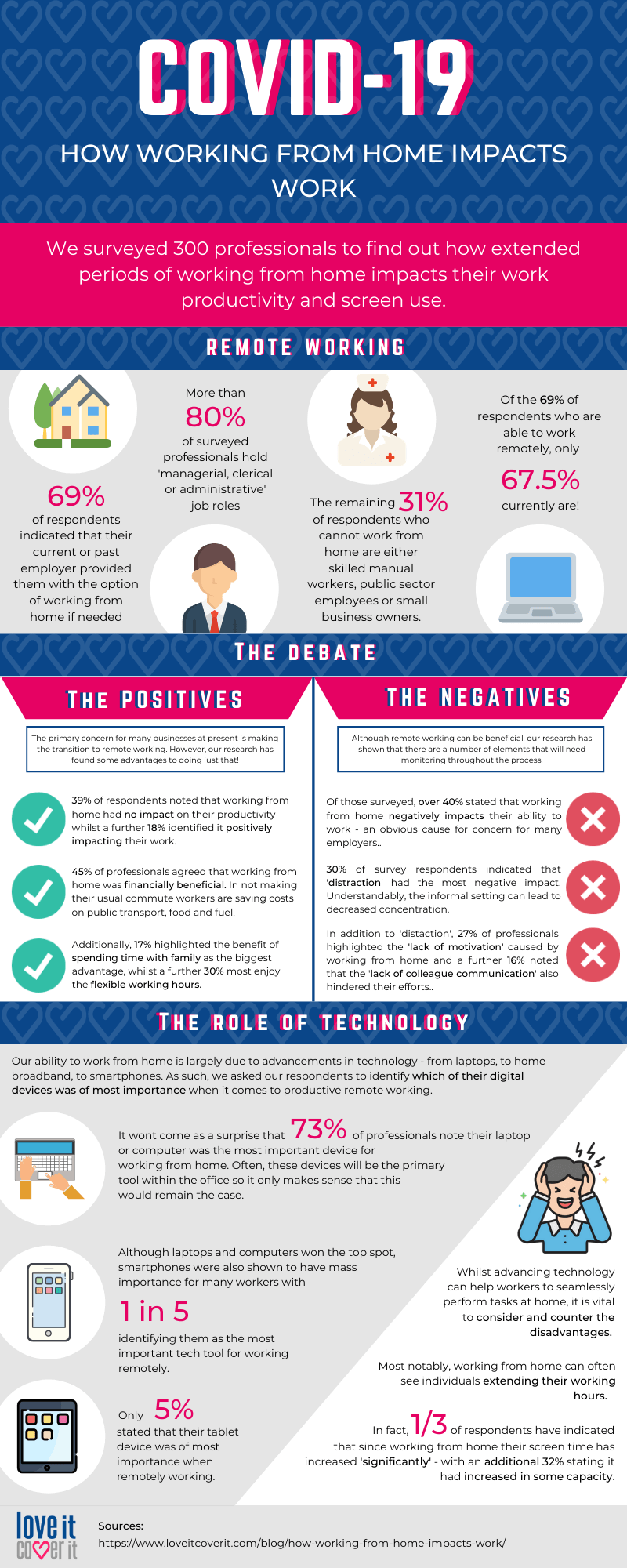COVID-19: How Working from Home Impacts Work
 By Jonathan Owen
By Jonathan Owen Marketing Manager
Published
7th April 2020
Last modified 31st July 2024
Last modified 31st July 2024
loveit? shareit!

Thanks to the wonders of modern technology, it’s now easier than ever for professionals, from across a spectrum of sectors, to work from home. With the help of shared cloud-based drives, smartphone applications, and fast in-home internet speeds, the transition from the office to the sofa is something that a lot of workers can (and do) take advantage of.
And the ability to work from home has a number of benefits for both employers and employees. Not only do remote working capabilities open up economic opportunities for people in disadvantaged areas – for example, allowing those in rural locations to work for larger, city-based companies without the need for relocation – but the flexibility that comes with working from home can actually have a positive impact on the mental health of professionals.
With the COVID-19 pandemic forcing thousands of UK businesses to explore remote working options – many in industries that wouldn’t otherwise try it under normal circumstances – it’s an important time to assess how working from home, long-term, impacts our ability to work. In order to get a comprehensive understanding of the benefits and drawbacks of remote working, and to see the role that technology is playing on a daily basis, loveit coverit surveyed 300 professionals across the country. Here’s what we discovered.
It’s undeniable that the spread of COVID-19 in recent months has put tremendous strain on businesses up and down the country. With many industries grinding to a halt, thousands of businesses furloughing staff, and many more adapting to remote working environments, it’s a tumultuous time for the vast majority of working professionals in the UK.
Of the 300 respondents to our independent survey, 69% indicated that their current employer – or previous employment – gave them the option of working from home if they needed it. This clearly demonstrates how flexible many businesses and sectors have become, whether they had policies in place before the outbreak of coronavirus, or whether they have adopted working from home practices due to the spread of the virus. Interestingly, over 80% of those surveyed are in ‘managerial, clerical, or administrative’ professions. While this gives us no indication about what they actually do, it does demonstrate that for some businesses in the ‘service’ sector, the ability to work from home is not an option.
Similarly, the remaining 31% who cannot work from home are either skilled manual workers, public sector employees, such as health care professionals, or small business owners.
Yet, whilst 69% of workers have the ability to work remotely, only 67.5% currently are. Although only a small percentage, it shows that some businesses either cannot cope with long-term office absense or have taken the difficult step to furlough employees in order to prevent economic damage.
Of those surveyed, over 40% stated that working from home negatively impacts their ability to work. Conversely, only 18% said that remote working was positive for their productivity, and 39% said there was no difference. Whilst it is good to see that 2 out of 5 individuals have no issue transitioning from the office to the home, the fact that the same percentage of professionals see it as a negative will be cause for concern for a lot employers – especially in these times of uncertainty.
In terms of the main disadvantages of working from home, the majority of respondents to our survey (30%) indicated that ‘distraction’ had the most negative impact. This is easy to understand, as the more informal setting of your own home lends itself more easily to distraction – especially if you’re also taking care of family members, children, or pets!
People also highlighted ‘lack of motivation’ (27%) and ‘lack of colleague communication’ (16%) as other main drawbacks of working from home. Similarly, 17% of workers indicated that the ‘impact on work-life balance’ was the primary negative for them. Considering the mental health ramifications of the COVID-19 lockdown, and the fact that over half of workers already have an unhealthy work-life balance, this is something that employers should be addressing and combating – ensuring that staff remain healthy and productive.
That said, the respondents did also highlight some advantages to remote working during this difficult period. 45% agreed on the cost-saving benefits of working from home – meaning that they’re saving money on commuting costs, food, and fuel. And in this time of economic hardship, it’s easy to see why this would be an advantage to so many.
Furthermore, 17% indicated that having the ability to spend more time with their family was the biggest advantage, while 30% highlighted flexible working hours. Interestingly, only 6% stated that ‘more efficient working’ was the primary benefit of doing business remotely.
As mentioned, the ability of some sectors to work from home, for extended periods of time, is due in no small part to advancements in technology – from laptops, to home broadband, to smartphones. And this is something that is clearly highlighted in our survey responses. Only 8% of respondents stated that a ‘lack of resources’ was the main drawback of working from home, suggesting that the vast majority of professionals have the tools and tech they need to work comfortably.
Unsurprisingly, the majority of respondents (73%) stated that their laptop or computer was the most important device for working from home. For so many in service industries, it is the primary tool in the office and is incredibly easy to transfer work from one device to another; or in the case of a laptop, to simply bring it home with you!
Nearly 1 in 5 of the people surveyed highlighted their smartphone as the most important piece of tech for remote working – demonstrating just how mobile tech has developed in recent years – while only 5% stated that their tablet device was most important for working from home.
While technology allows a lot of workers to seamlessly perform tasks from home, it isn’t without its own disadvantages. One of the biggest issues with the COVID-19 lockdown and increase in remote working is that people are spending more and more time ‘at work’. Not only does this create a poor work-life balance as discussed, but it also means that individuals are spending more time in front of screens, which can have a negative impact on health. Indeed, a third of all respondents to the survey indicated that, since working from home for an extended period of time, their screen time has increased ‘significantly’, while another 32% stated that it had increased in some capacity. By contrast, only 6.6% said that their screen time has decreased by any amount.
